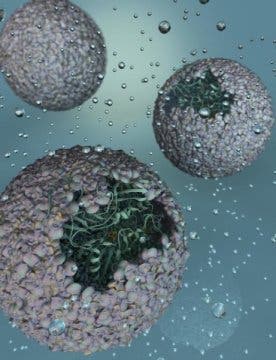Indiana University scientists have built a highly efficient bio-material that can serve as a catalyst for hydrogen production. This material takes us halfway towards the long sought-after “holy grail” of splitting water to make hydrogen and oxygen for fueling cheap and efficient cars that run on water.

Image via sciencedaily
The team started with an enzyme called hydrogenase that can extract pure hydrogen gas out of water. The substance broke down easily however, so they strengthened it by placing it inside the capsid (the protein shell) of a bacterial virus. The new material is now 150 times as efficient than the unaltered enzyme.
Essentially, we’ve taken a virus’s ability to self-assemble myriad genetic building blocks and incorporated a very fragile and sensitive enzyme with the remarkable property of taking in protons and spitting out hydrogen gas,” said lead author Trevor Douglas, the Earl Blough Professor of Chemistry in the IU Bloomington College of Arts and Sciences’ Department of Chemistry.
“The end result is a virus-like particle that behaves the same as a highly sophisticated material that catalyzes the production of hydrogen.”
The hydrogenase was produced using genetic material harvested from the common bacteria Escherichia coli, namely the genes hyaA and hyaB. The enzyme was then inserted inside the protective capsid of a virus known as bacteriophage P22,using methods previously developed by IU scientists.
The resulting biomaterial, called “P22-Hyd,” is much more efficient and durable than the enzyme alone, and is obtained through fermentation process at room temperature. P22-Hyd is dirt cheap (fermentation is free) and more environmentally friendly than materials currently used for fuel cells. The authors compare it to platinum, the most commonly used hydrogen catalyst today.
“This material is comparable to platinum, except it’s truly renewable,” Douglas said.
“You don’t need to mine it; you can create it at room temperature on a massive scale using fermentation technology; it’s biodegradable. It’s a very green process to make a very high-end sustainable material.”
As a bonus, P22-Hyd both breaks the chemical bonds of water to create hydrogen and also works in reverse to recombine hydrogen and oxygen to generate power.
“The reaction runs both ways — it can be used either as a hydrogen production catalyst or as a fuel cell catalyst,” he added.
Out of three naturally ocuring forms of hydrogenase, the team chose to use nickel-iron (NiFe)-hydrogenase — the others being di-iron (FeFe)- and iron-only (Fe-only)-hydrogenase. This form was preferred due to its ability to easily integrate into biomaterials and tolerate exposure to oxygen.
Unaltered NiFe-hydrogenase is highly susceptible to destruction from chemicals in the environment and breaks down at room temperatures — a poor choice for fuel cells. Encapsulation allows it much greater chemical resistance and enables it to catalyze at temperatures exceeding “comfortable,” permitting its use in manufacturing and commercial products such as cars.
“[These shortcomings are] some of the key reasons enzymes haven’t previously lived up to their promise in technology,” Douglas added.
Another is their difficulty to produce.
“No one’s ever had a way to create a large enough amount of this hydrogenase despite its incredible potential for biofuel production. But now we’ve got a method to stabilize and produce high quantities of the material — and enormous increases in efficiency.”
Seung-Wuk Lee, professor of bioengineering at the University of California-Berkeley, whose work has been cited in a U.S. Congressional report on the use of viruses in manufacturing and unaffiliated with the study, applauds the team’s work, saying:
“Douglas’ group has been leading protein- or virus-based nanomaterial development for the last two decades. This is a new pioneering work to produce green and clean fuels to tackle the real-world energy problem that we face today and make an immediate impact in our life in the near future.”
Beyond the new study, Douglas and his colleagues continue to craft P22-Hyd into an ideal ingredient for hydrogen power by investigating ways to activate a catalytic reaction with sunlight, as opposed to introducing elections using laboratory methods.
“Incorporating this material into a solar-powered system is the next step,” Douglas concluded.






